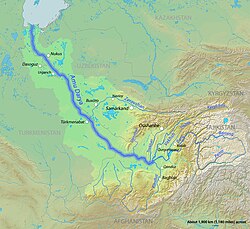| Zarafshon | |
|---|---|
 River Zarafshon near Panjakent, Tajikistan | |
 The Zarafshon in the Amu Darya basin | |
| Location | |
| Country | Tajikistan, Uzbekistan |
| Physical characteristics | |
| Source | Zeravshan Glacier |
| • coordinates | 39°30′N70°35′E / 39.500°N 70.583°E |
| Mouth | Qorakoʻl oasis |
• coordinates | 39°32′52″N63°52′08″E / 39.5477°N 63.869°E |
| Length | 877 km (545 mi) |
| Basin size | 17,700 km2 (6,800 sq mi) |
| Basin features | |
| Cities | Panjakent, Samarkand, Bukhara |
| Tributaries | |
| • left | Fan Darya, Kshtut, Magiyan |


The Zarafshon [2] [a] is a river in Tajikistan and Uzbekistan. Its name 'spreader of gold' in Persian refers to the presence of gold-bearing sands in the upper reaches of the river. It was known as the Polytimetus by the ancient Greeks. [3] The river is known in Russian as Zeravshan, [b] and it was also formerly known as the Sughd River. [4] The river is 877 kilometres (545 mi) long and has a basin area of 17,700 square kilometres (6,800 sq mi). [5]
